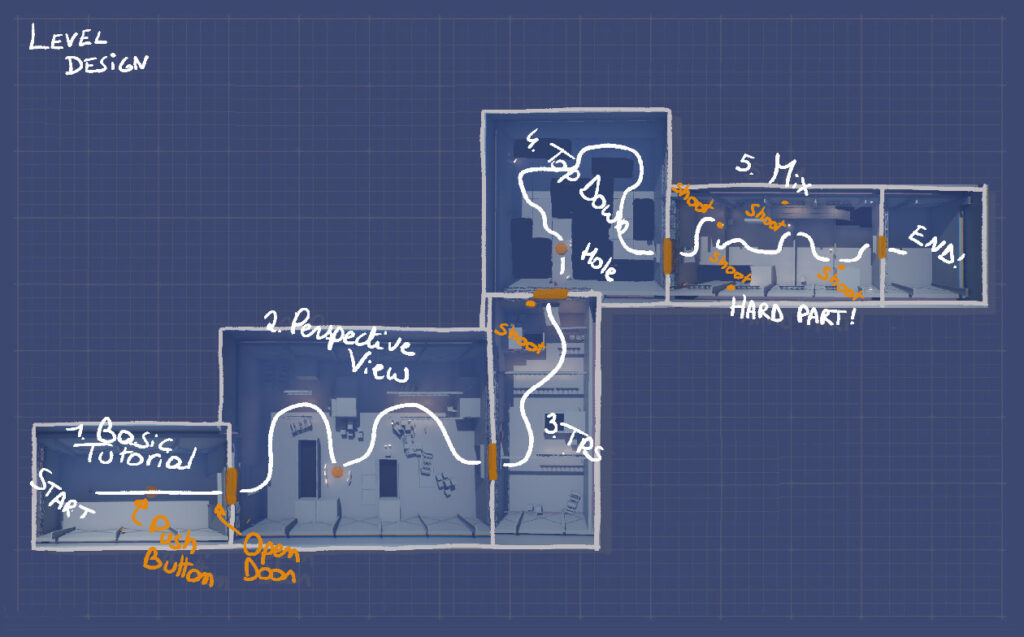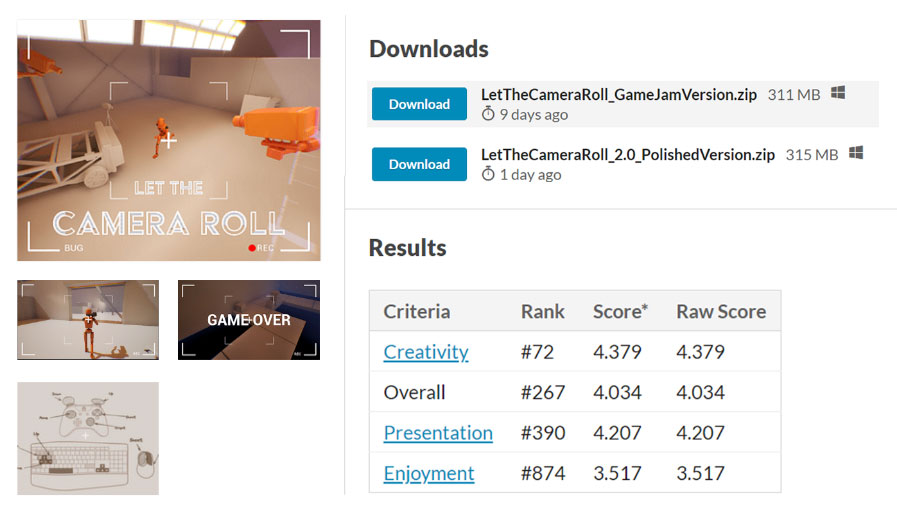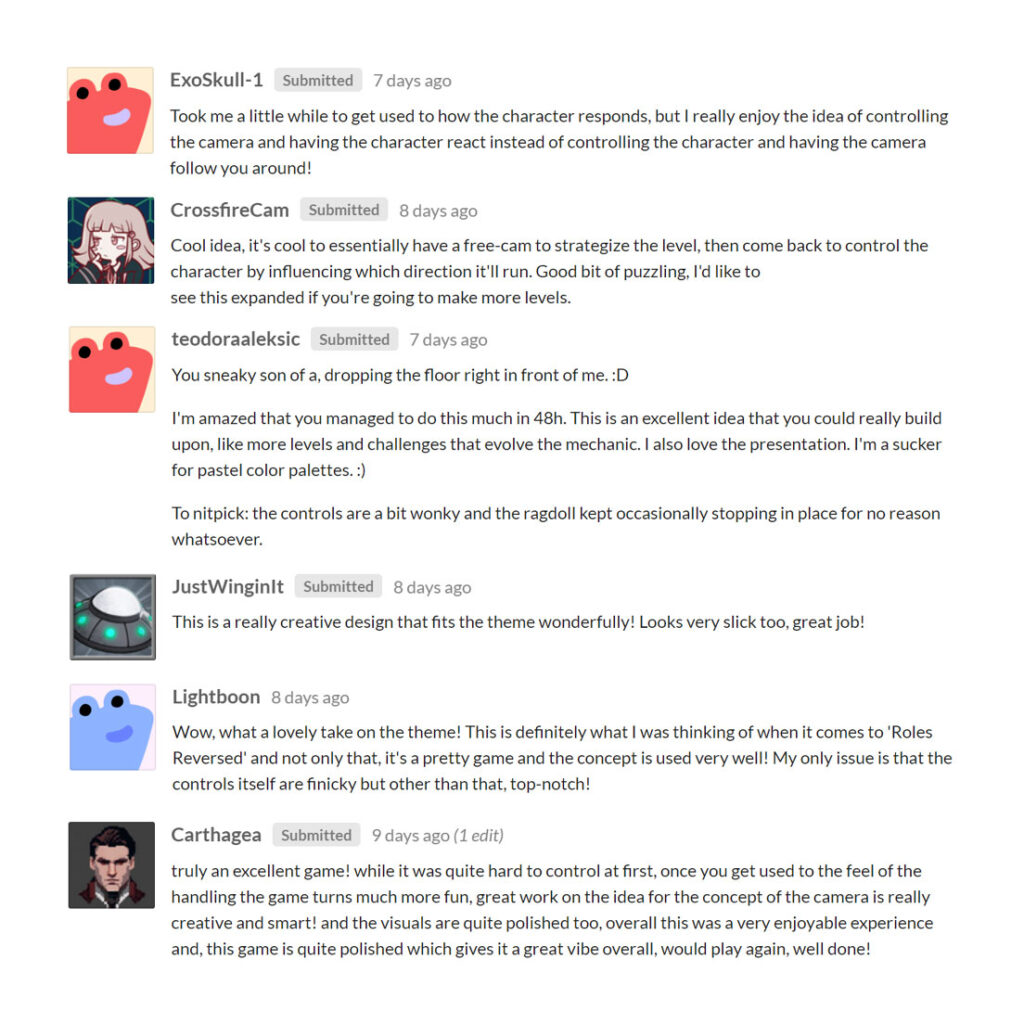Hello Everyone,
We’re back with some exciting news : We took part in our second GMTK game jam! If you don’t remember why it’s such a big deal or want to know how we did last year, check out our previous adventure here.
Prelude
The competition ran from July 7th to July 9th 2023. Like almost 20,000 other groups worldwide, we had 48 hours to create a complete game based on a theme revealed at 7 PM (CEST) on Friday. After these two intense days came the second, equally challenging, phase: promoting our game and striving for top rankings through community voting.
Like last year, we wanted to challenge ourselves and to see what we were capable of creating in such a short time. As a team, we also wanted to share a memorable event centred on a tangible goal. Unfortunately, one team member couldn’t participate, but we prepared and delegated tasks in advance. On the bright side, we were lucky to welcome a 3D animator and a composer into our team for the entire Game Jam.
With the context set, let’s dive into our journey!
H-48 : Idea
At 7 p.m. on Friday, the 5 of us gathered around the screen to discover the theme.

The countdown had begun…
Driven by the Bottom Up (Games) spirit, we wanted to focus on a unique gameplay concept or control inversion. However, we only had 48 hours to come up with an idea at once original and feasible.
After a few hours of brainstorming, we all agreed and took the leap.
Our vision was for players to assume the role of the camera itself, rather than controlling the character directly. In terms of originality, it seemed promising. But how could we execute it effectively and ensure that players would swiftly grasp the game’s unusual controls?
H-45 : Development
We immediately thought of the typical camera typologies and the imagery associated with them. We decided to pay homage to these well-known archetypes by centring our concept around the role of the camera in video games.
The players would be able to switch between different gameplay modes by changing the camera angle.
The game would revolve around:
- The Large Perspective View : a distant and global view allowing easy movement in large rooms.
- The Top Down View : like following a mouse in a 2D maze, the camera looks down on the player.
- The Third Person Shooter View : an over-the-shoulder view to aid in aiming and shooting.
- The Side Scrolling View : a retro angle where the camera follows the character from the side.

Depending on the chosen camera angle, the character would automatically mimic the corresponding gameplay style and move to reposition itself at the center of the screen. When the camera is too far from the character, they wait patiently in T-pose. This “one camera angle = one gameplay mode ” rule helped structure our whole game development.
As for the general context, we quickly agreed on a crash test laboratory with a simple and pure esthetic somewhat similar to the iconic game “Portal”. The player’s objective would be to control the camera and guide the dummy from room to room, subjecting them to a series of tests. All without causing them any harm, of course.
Naturally, a series of challenges still awaited us. Most of these challenges were technical, involving the implementation of AI and the creation of sound that evolved throughout the game. We also had to ensure that we could create a playable and bug-free game using Unreal Engine 5.
While we were highly motivated, we were still a bit nervous. We were well aware of the inherent issues related to camera controls in most video games. Perhaps making the camera the subject of a Game Jam project was overly ambitious. Especially since our focus was on enabling smooth transitions between camera modes, not just managing one of them.
H-42 : Rush#1
With a tight schedule and lots of tasks ahead, we wasted no time and dived into action: creating 3D assets and animations, developing AI, experimenting with music, setting up menus, and laying the foundation for the game’s overall architecture.
H-32 : First group feedback
After a few hours of work, we had a basic foundation so we were able to test the camera management. It didn’t work, so we swiftly changed our approach and implemented a magnet camera system.
In this new approach, collision spheres follow the character at their respective positions. When the camera enters one of these spheres, it is attracted like a magnet and automatically aligned to the appropriate viewing angle, unlocking unique behaviours for each chosen mode.
Thankfully, this new system worked immediately!
As the view modes still seemed somewhat too similar, we took advantage of this setup to dynamically manage the soundscape by associating a specific iteration of music with each camera mode. This way, the player would gain a better sense of the game’s progression, while experiencing changing atmospheres based on their actions.

H-28 : Rush#2
Alongside the camera work and the general development of tools, sounds and animations, it was high time to start designing the levels. This task proved slightly challenging when the game wasn’t playable yet. Though we each had our own idea of the desired outcome, without the essential part of playtesting, we had to rely on our communication, our instincts and our level designer.
After a brief period of uncertainty during Saturday night, we gathered all our motivation so that by Sunday morning, it was time to retest the general pooling.

H-12 : Second group feedback
Finally, we could test our levels and get our character moving… or rather, our camera. The magic of the second night had worked its wonders: our game was playable!
We felt truly relieved. It was time to integrate the animations and sounds into the mix. Everything was coming to life.
H-9 : Rush#3
Following the weekend’s “rush” motto, we spent the final hours of the competition trying to address any remaining issues. From sound and lighting problems to collisions and level design, we rushed through these adjustments until the very last minute.
H-0.01 : Submission
And we submitted our game on time! What a relief.
We were already very proud of having managed to create our game. Yes, there were still some sound and control issues. Yes, we had to set aside a few camera modes (and therefore levels). Yet, our game could be considered complete, original, quite visually appealing, with music, sound effects, and a menu featuring settings to allow playing on any computer.
But there was no time to rest. Instead, we embarked on the second stage of the competition. An equally crucial stage: voting.
H+0.01 : Voting Rest
H+14 : Voting and promotion
Last year, this second part of the competition had caught us off guard. After creating our game, we hadn’t anticipated the need to promote it to receive good votes—or any votes at all. This year, we were prepared, but it was no less challenging. Despite residual fatigue, we had to dive into it. This stage demands time and personal involvement.
Our game needed to stand out with an original concept, appealing design, and eye-catching images or GIFs. But that’s not all, we also had to make ourselves noticed among nearly 7000 other entries. Thus, we had to generate some awareness about our game so people could test it and, most importantly, give us their feedback. We were excited about this part, eager to know which aspects were well-received and which needed further improvement. Additionally, we looked forward to discovering other unique concepts and learning from the work of other participants.
Although we are not necessarily accustomed to interacting with an unfamiliar community, we were genuinely interested in exchanging ideas and receiving feedback from other developers!
At the same time, we also worked on gradually improving our game. Our goal was to fine-tune the version presented in the game jam so that it felt complete. We focused on these enhancements while staying true to the idea of the game we had created within the 48-hour timeframe. While we didn’t add additional modes like the side scroller or point-and-click, we focused on refining the controls, music, sound effects, and overall game experience.
H+216 : Results
Nine days after the Game Jam ended and two days after the voting period, it was time to reveal the results.
While we didn’t expect to be among the top 100, we were still hoping for some positive feedback from the community. The comments we received had already brought us joy and provided valuable insights into our work. However, being in a competition, we were curious about how we had fared among all these high-quality games.

So, we ranked 267th! With a respectable 72nd place in creativity and an overall average of 4/5.
Conclusion
We are very pleased with our result, but above all, we’re genuinely proud of what we achieved together in such a short time. Testing our limits and seeing what a small team can accomplish when working towards a common goal is always fascinating.
Throughout this experience, we learned a great deal:
- We successfully focused on the overall result to be achieved, organically narrowing our focus over the weekend without frustration.
- Working with specialized professionals from other fields, we integrated them into our usual workflow to make the most of their expertise. We had a fantastic time collaborating with them.
- We endured stress together without getting upset or giving up.
- Most importantly, we demonstrated resourcefulness and teamwork, which, for us, embodies the essence of game development!
Well done, team ! A big thank you to Tonhi Nguyen and César Roba (Mr.SeizeArts) for their invaluable assistance.
Thank you for reading, and feel free to test our game on itch.io at bottom-up-games.itch.io/let-the-camera-roll
We’ll be back soon with more news, this time about the game we’re currently developing!



